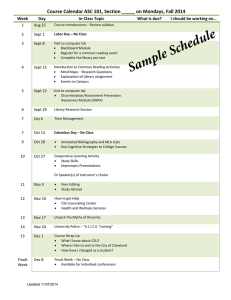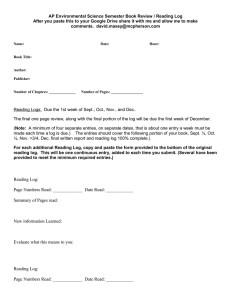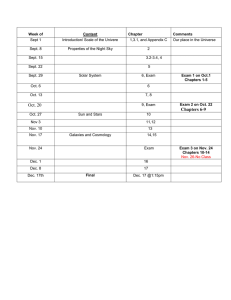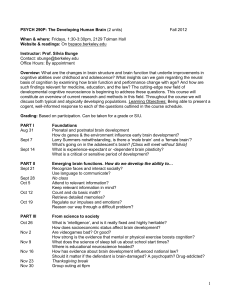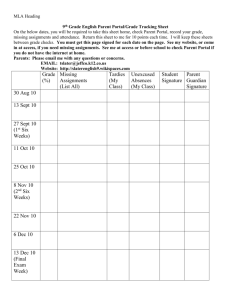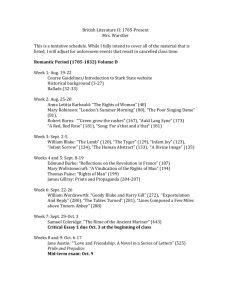Queens College ... Astronomy II Day ... Fall 2008
advertisement
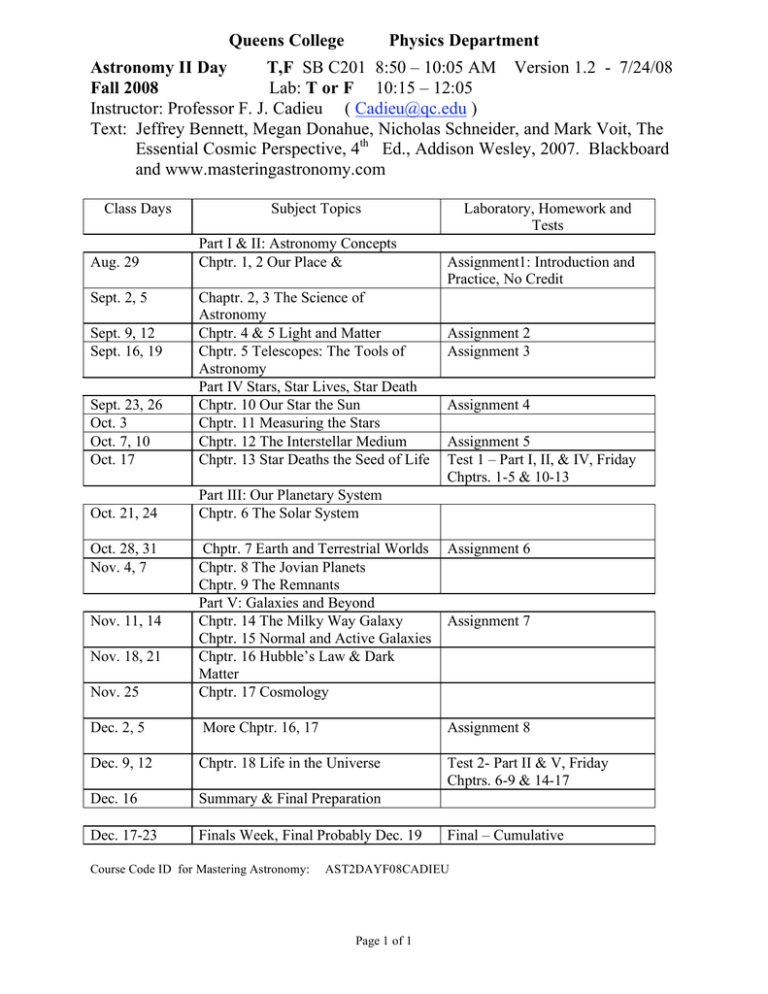
Queens College Physics Department Astronomy II Day T,F SB C201 8:50 – 10:05 AM Version 1.2 - 7/24/08 Fall 2008 Lab: T or F 10:15 – 12:05 Instructor: Professor F. J. Cadieu ( Cadieu@qc.edu ) Text: Jeffrey Bennett, Megan Donahue, Nicholas Schneider, and Mark Voit, The Essential Cosmic Perspective, 4th Ed., Addison Wesley, 2007. Blackboard and www.masteringastronomy.com Class Days Aug. 29 Sept. 2, 5 Subject Topics Part I & II: Astronomy Concepts Chptr. 1, 2 Our Place & Sept. 23, 26 Oct. 3 Oct. 7, 10 Oct. 17 Chaptr. 2, 3 The Science of Astronomy Chptr. 4 & 5 Light and Matter Chptr. 5 Telescopes: The Tools of Astronomy Part IV Stars, Star Lives, Star Death Chptr. 10 Our Star the Sun Chptr. 11 Measuring the Stars Chptr. 12 The Interstellar Medium Chptr. 13 Star Deaths the Seed of Life Oct. 21, 24 Part III: Our Planetary System Chptr. 6 The Solar System Sept. 9, 12 Sept. 16, 19 Oct. 28, 31 Nov. 4, 7 Laboratory, Homework and Tests Assignment1: Introduction and Practice, No Credit Assignment 2 Assignment 3 Assignment 4 Assignment 5 Test 1 – Part I, II, & IV, Friday Chptrs. 1-5 & 10-13 Assignment 7 Nov. 25 Chptr. 7 Earth and Terrestrial Worlds Chptr. 8 The Jovian Planets Chptr. 9 The Remnants Part V: Galaxies and Beyond Chptr. 14 The Milky Way Galaxy Chptr. 15 Normal and Active Galaxies Chptr. 16 Hubble’s Law & Dark Matter Chptr. 17 Cosmology Dec. 2, 5 More Chptr. 16, 17 Assignment 8 Dec. 9, 12 Chptr. 18 Life in the Universe Test 2- Part II & V, Friday Chptrs. 6-9 & 14-17 Dec. 16 Summary & Final Preparation Dec. 17-23 Finals Week, Final Probably Dec. 19 Nov. 11, 14 Nov. 18, 21 Course Code ID for Mastering Astronomy: Assignment 6 Final – Cumulative AST2DAYF08CADIEU Page 1 of 1 Introductory Astronomy 2 Day: The Essential Cosmic Perspective Professor Fred J. Cadieu Tu, Fr 8:50-10:05 AM, Science Building, Room C201 Office: SB B202. Phone: 718 997-3364, e-mail: Cadieu@qc.edu Office hours: Tu, Th 1-2 PM General Information Astronomy 1 and 2 are general introduction to modern astronomy courses. Astronomy 2 includes a laboratory component and satisfies the Queens College requirement for a science course with a laboratory. The lecture parts of these courses are very similar. No scientific or mathematical background is assumed, beyond the entrance requirements to CUNY. Astronomy is a science, however, so you will be expected to develop your critical thinking skills in order to understand and apply the scientific method. In terms of mathematics, we will use only arithmetic and a bit of simple algebra. Credit can be earned for either Astronomy 1 or 2, but not for both. These courses are not designed as a sequence. Our main point of interest will be the big picture that illustrates our place in the universe. There have many new discoveries over the last decade and particularly since the start of the space age that have changed our view of the universe. New discoveries about our neighboring planets have made comparative planetology an important tool in essentially directing a telescope toward the Earth. This new knowledge gives an appreciation of the Earth as a very special place in our solar system. We will not try to memorize many particulars that used to be a big part of introductory astronomy courses. As a PLAS course, General Astronomy fulfills an Area of Knowledge and Inquiry requirement by teaching students a natural science and the scientific process: how scientists and mathematicians collect and explain astronomical data, from viewing without instrumentation to observation with optics, spectroscopy, x-ray and gamma rays. The students will appreciate how instruments and theories of science have evolved over time, building on milestone achievements of the past (eg., Newton building on Galileo’s work, Einstein’s Theory of Relativity leading to the work of Hubble and the Big Bang Theory). Close attention is paid to the process of posing questions in order to keep a theory open to rigorous experimental testing. Students will be engaged to critically think and discuss as active citizens about two modern dialogues in science: (1) the unique role of Earth in the solar system as a habitat for life versus the problem of global climate change; (2) how the birth of nuclear science has led to our understanding of the Sun's energy output, the development of nuclear weapons, and current debate over the control and employment of such weapons or energy sources. Required Textbooks/Media The textbook for this course is The Essential Cosmic Perspective, fourth edition, by Bennett, Donahue, Schneider, and Voit. You will also need a personal access kit for the MasteringAstronomy website and the SkyGazer CD, both of which should have come with your book if you purchased a new copy. (Note: If you purchased a used copy of the book, you must buy access to the website online at www.masteringastronomy.com.) Course Code ID for Mastering Astronomy: AST2DAYF08CADIEU Page 2 of 2 Course Requirements and Grading Astronomy Grading Policies Fall 2008 Semester The Course Grade will be determined from the following course components. Two in-class midterm exams with the best score weighted twice as much as the lower score in determining a test average. On-line homework from www.masteringastronomy.com In-class attendance & quizzes, weeks 3 to week 14 Lecture Part of Course Course Final, The Final will be cumulative and will be weighted either at 15% or at 40% which ever results in the higher score for the student. Combined Lecture and Final Combined Lecture and Final Scores Astronomy 2 Laboratory Course 38% 37% 25% 100% 15% or 40% whichever gives higher score. 100% 66.7% 33.3% 100% Letter grades are assigned in terms of the normal Queens College grade equivalence. A+ A A- 97-100 93-96 90-92 B+ B B- 87-89 83-86 80-82 C+ C C- 77-79 73-76 70-72 D+ D F 67-69 60-66 0-59 In principle every student can earn an A or even A+, but that goal is usually as elusive as reaching to the edges of the universe. • Observing sessions: We will have several nights where campus telescopes will be set up for observing the skies. You are encouraged to attend these observing sessions. Common Courtesy Guidelines For the benefit of your fellow students and your instructors, you are expected to practice common courtesy with regard to all course interactions. For example: • • • Show up for class on time. Turn off your cell phones before class begins! Do not leave class early, and do not rustle papers in preparation to leave before class is dismissed. • Be attentive in class; stay awake, don't read newspapers, etc. • If you must be late or leave early on any particular day, please inform your instructor or TA in advance. • Play well with others. Be kind and respectful to your fellow students and your teachers. You can expect your grade to be lowered if you do not practice common courtesy. Can I Get the Grade I Really Want? Yes—but it will depend on your effort. It does not matter whether you have even learned anything about astronomy before or whether you are "good" in science. What does matter is your willingness to work hard. Astronomy is a demanding course, in which we will move quickly and each new topic will build on concepts covered previously. If you fall behind at any time, you will Page 3 of 3 find it extremely difficult to get caught back up. If you want to get a good grade in this class, be sure to pay special attention to the following: • • • • • • Carefully read the section in the Preface of your textbook called "How to Succeed in Your Astronomy Course." It describes how much time you should expect to spend studying outside class and lists a number of useful suggestions about how to study efficiently. When you turn in assignments of any kind, make sure they are done clearly and carefully. Refer to the separate handout on "Presenting Homework and Writing Assignments." Don't procrastinate. The homework assignments will take you several hours, so if you leave them to the last minute you'll be in trouble—and it will be too late for you to ask for help. Both quizzes and homework need to be completed on time if you want to avoid late penalties. Don't miss class, and make sure you come to class prepared, having completed the assignments due by that date. Don't he a stranger to your instructor—come see me in office hours, even if you don't have any specific questions. If you find yourself confused or falling behind for any reason at any time, let me know immediately! No matter what is causing your difficulty, I am quite willing to work with you to find a way for you to succeed—hut I can't help if I don't know there's a problem. A Closing Promise All the hard work described above might sound a hit intimidating, but I can make you this promise: Few topics have inspired humans throughout the ages as much as the mysteries of the heavens. This class offers you the opportunity to explore these mysteries in depth, learning both about our tremendous modern understanding of the universe and about the mysteries that remain. If you work hard and learn the material well, this class will be one of the most rewarding classes of your college career. Page 4 of 4 Lab Schedule ASTRONOMY 2 Fall 2008 The laboratory will utilize a combination of astronomy related equipment and telescopes, and some simulated equipment measurements made on computers. Laboratory notes will be distributed at the beginning of each lab period. The computerized experiments are the Virtual Astronomy Laboratory Software Version 3. Queens College has a site license for this software. The virtual astronomy experiments allowed measurements to be made using simulated expensive equipment that would not usually be available to students. The virtual astronomy laboratories are designated by unit numbers. Some astronomy laboratory exercises from Astonomy Through Practical Investigations by G. Lomoga, W. Smiley and R. Warasila may be utilized. This part of the course is under revision. Each experiment is integrated with appropriate exercises to form a project. Each project will take 3 sessions except the Sun & Moon, which will take 1 session each. Ast. 2 Day Labs. Either Tu or Fr, Ast. 2 Eve. Labs. Either Tu or Th The Laboratory projects will be performed in the order indicated on page 6. Note that some lab sections have a slightly different order to allow equipment to be setup for the different classes. Laboratory Classes 1. Attendance at each laboratory class is compulsory. 2. It is intended that students should complete as much as possible of each exercise during the laboratory session. So each laboratory exercise will be collected at 12:00 P.M. (or at 8:15 P.M.) at the end of the laboratory session assigned to that exercise. Exercises will not be accepted after the end of the class. 3. Students should prepare for each lab class by reading the explanations in the exercises and the textbook. A calculator is available in the lab. 4. Leave the lab bench for the next class as you would like to find it! Put the equipment away tidily and remove all garbage after class. Page 5 of 5 Astronomy 2 Laboratory Schedules Fall 2008 Lab. Day 1 Lab. Day 2 Lab. Day 3 Lab. Day 4 Lab. Day 5 Lab. Day 6 Lab. Day 7 Lab. Day 8 Lab. Day 9 Lab. Day 10 Lab. Day 11 Lab. Day 12 Lab. Day 13 Lab. Day 14 Ast. 2 Day Tu Lab. Topic Ast. 2 Day Fr. Lab. Topic Ast. 2 Eve. Tu Lab. Topic Ast 2 Eve. Th Lab. Topic Sept. 2 A Aug. 29 A Sept. 2 A Aug. 28 A Sept. 9 A Sept. 5 A Sept. 9 A Sept. 4 A Sept. 16 Sept. 23 Oct. 7 A Sept. 12 A Sept. 16 A Sept. 11 A M Sept. 19 M Sept. 23 M Sept. 18 M S Sept. 26 S Oct. 7 S Sept. 25 S Oct..21 B Oct. 3 B Oct..21 B Oct. 2 B Oct. 28 B Oct. 10 B Oct. 28 B Oct. 16 B Nov. 4 B Oct. 17 B Nov. 4 B Oct. 23 B Nov. 11 Oct. 24 Nov. 18 Unit 24,25 D Oct. 30 Oct. 31 Unit 24,25 D Nov. 11 Nov. 18 Unit 24,25 D Nov. 6 Unit 24,25 D Nov. 25 D Nov. 7 D Nov. 25 D Nov. 13 D Dec. 2 Unit 28 Nov. 14 Unit 28 Dec. 2 Unit 28 Nov. 20 Unit 28 Dec. 9 Unit 29 Nov. 21 Unit 29 Dec. 9 Unit 29 Dec. 4 Unit 29 Dec. 16 Unit 30 Dec. 5 Unit 30 Dec. 16 Unit 30 Dec. 11 Unit 30 Laboratory Topic Project A M S B D E Celestial Sphere Moon Sun Telescopes Photometry Spectra SkyGazer Units 24, 25, 26 Units 28, 29,30 Page 6 of 6
